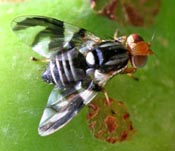
Probably no other type of pest is as damaging to home fruit production as the apple maggot, a.k.a. railroad worm. It is native to this part of the world and is ubiquitous throughout the state. It occurs during mid to late summer, when many families are taking their summer vacations, and even a brief lack of attention can result in substantial fruit infestation.
Although the apple scab fungus may be more uniformly common throughout the state, and is more of a concern to commercial orchardists, a couple of factors make it less important than apple maggot to home growers. First, very good quality scab-resistant cultivars are available which are highly immune to apple scab; no such cultivars are available for managing apple maggot. Second, small scab infections on the surface of the fruit are usually tolerable to home growers because the underlying fruit is generally unaffected; in the case of apple maggot, a single larva tunneling through the fruit will ultimately result in total decay of that fruit.
Biological Information
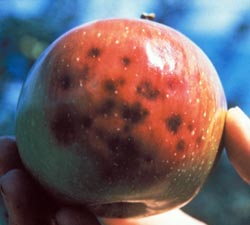
Damage. Flies lay one or more eggs under the surface of the apple skin. The area of egg laying will eventually become sunken and darken as rot begins to develop. The larvae tunnel throughout the fruit (unlike codling moth which feeds primarily in the core area). Their tunneling results in slender darkened trails throughout the fruit; these areas of decay will expand until the entire fruit becomes rotten. Usually infested fruit fall from the tree prematurely. Larvae develop relatively slowly at first and, because they are of small size and their color matches that of the flesh of the apple, they are not easily seen. In many cases, the trails may be minimal and the infested fruit may appear healthy other than a few small areas of light discoloration. At this stage, it is likely that many young apple maggots are inadvertently consumed every year, as the fruit still appears sound when the maggots are just beginning their development. Healthy-appearing, but infested, fruit may also be put into storage, where the apple maggot larvae will continue their development, resulting in fruit decay in storage.
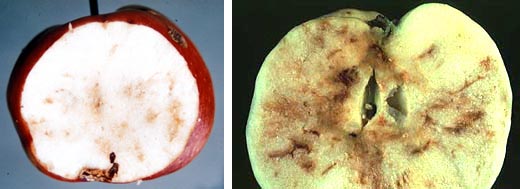
Description. The apple maggot (Rhagoletis pomonella) is a fly about 5-6 mm (3/16 – 1/4″) long (somewhat smaller than the house fly). It has a distinctive banding pattern on the wings in the shape of a “W”, a prominent white spot in the center of the body just behind the area where the wings attach, and the abdomen (posterior body region) is black with thin white bands. The larval stage is a typical maggot in form: cylindrical, blunt at the tail end and somewhat pointed at the front end. It is about 8 mm (5/16″) long when fully grown, usually cream colored, legless, and without a distinct head other than a pair of small black, hook-shaped mouthparts.
Life cycle. The important thing to remember about the apple maggot is that, unlike other important early-season apple pests, this insect is a pest during mid to late summer.
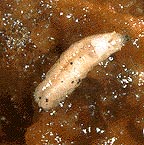
The apple maggot spends the winter in the pupal stage a few inches deep in the soil. It remains there until the end of June or early July. At this time, if there is adequate soil moisture, the flies will dig their way to the surface. If the soil is dry, they will remain until rain or irrigation is adequate. Not all flies emerge at once – there can be continued emergence into early September. After emerging from the soil, the adults feed on organic residues (pollen, honeydew, etc.) found on leaf surfaces for a period of about 7-10 days before the females can produce eggs. Each female can lay 300-500 eggs over a period of a few weeks. Eggs hatch within a few days and the tiny larvae begin to tunnel through the fruit. Larval development takes from 2 weeks to 6 weeks or more; larvae develop faster in warm weather and in softer fruit (riper, or softer cultivars). By the time they are done feeding, the apple has usually fallen to the ground, and the developed larvae tunnel about 2” deep into the soil and pupate, where they remain until the following year. There is a single generation per year in Wisconsin.
Host range. It is primarily a pest of apple, preferring to feed on earlier, softer, sweeter cultivars. It also infests pear, crab apple, and stone fruits. Before colonial times, apple maggot fed primarily on hawthorn and it wasn’t until the 1800s that a form evolved that could feed on apple. There are two forms today; they are virtually indistinguishable and are still considered the same species. However, generally, the hawthorn form will not go to apple and the apple form will not go to hawthorn. Blueberry maggot, Rhagoletis mendax, looks virtually identical but is restricted to blueberry and related hosts.
Geographic range. Apple maggot is native to the northeastern and midwestern United States and adjacent Canada. It was accidentally introduced into the western United States in the late 1970s.
Management
Although a serious pest, apple maggot is not difficult to control and several options exist.

Monitoring. Two types of traps are available for monitoring the occurrence of apple maggot flies. The first type is a yellow card with a sticky material applied, and baited with a chemical that smells like food to the adult flies. The flies are attracted to these traps when they are still feeding and before they start laying eggs. You will have about a week from the time you catch the first fly until control is necessary. Note that unbaited yellow traps are also available but are much less effective.
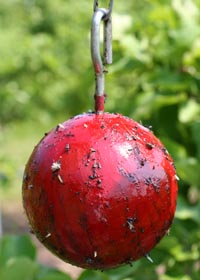
The second type of trap is a red sphere, to mimic the size and shape of a ripe apple, and also covered with a sticky material. A different type of lure, with a fragrance like ripe fruit, is used to bait this type of trap. By the time the flies are attracted to this trap, they are sexually mature and ready to lay eggs. As with the yellow trap, the red sphere can be used unbaited, but is much less efficient in catching flies. The red sphere trap can also be used for controlling apple maggot – see below.
Either or both types of traps can be used for monitoring. Traps should be hung in the trees about the last week in June. For monitoring purposes, it is recommended that two traps be used for small home orchards.
Note that many types of insects will land on these traps and become stuck. If you are using traps as a way to time insecticide sprays, you will need to be able to positively identify the apple maggot fly from all the other types of insects likely present on the traps.
Traps are available at better garden centers or through various gardening catalogs and Internet sources.
Control
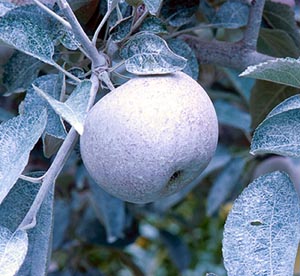
Insecticides – conventional and organic. Probably the simplest approach is the use of a conventional insecticide 2-3 times during summer. Most conventional insecticides will give about 2 weeks of control before they lose effectiveness. If you have early-maturing varieties (harvest in August to early September), make the first insecticide application during the first week in July with subsequent applications during the third week of July and the second week of August. This will provide good fruit protection (but perhaps not 100% if the fly population is large in your area). Note that organically-approved insecticides may also be used, but they tend to lose their effectiveness much more rapidly, and therefore may need to be applied more frequently to achieve the desired level of control.
A modified approach is to base the start of spraying on trapping results. If no flies are appearing in the traps, it is unnecessary to control. This may allow you to delay the timing of the first application, and to reduce the total number of applications.
When using insecticides, be sure to use an insecticide that is registered for use on apples. Also be sure to observe the required preharvest interval (mandatory time between the last application and start of harvest).
One organically-approved insecticide available for apple maggot control is based on naturally occurring kaolin clay that is mined and processed as a very fine powder. One trade name is Surround™. The powder is mixed with water and sprayed onto the trees, providing a “particle film” barrier that the insects dislike (it does not kill the insects). It must be applied weekly as the fruit grow. Although not 100% effective against apple maggot, it tends to provide enough control for many gardeners. One aspect of this material is that it results in a residue of white clay on the fruit surface which must be washed off using a fruit brush at harvest. Kaolin clay is considered relatively non-toxic in the quantities used and can be used up to the day of harvest.
Trapping for control. If populations are low to moderate, the baited red sticky spheres discussed in the monitoring section above can be used for fairly successful control. Use one trap in a small tree (less than 8 ft tall), 2-4 traps in a medium sized tree, and 6-8 traps in a large tree (20-25 ft). The traps must be maintained by removing the accumulated dead insects every couple weeks, and new sticky material applied as needed. If populations in the area are high, trapping alone may not provide adequate control.
Bagging for control. Studies have shown that developing apples can be protected by bagging them when they are young. Sandwich-size plastic bags are used, with the opening stapled shut tightly around the fruit stem. A small slit is cut in the bottom corner of the bag to allow condensation to drain. The apples will mature normally, and will have a normal taste and texture.

Sanitation for control. If possible, eliminate unmanaged host plants within 200 yards of the apple trees. It is especially important to eliminated unmanaged apples, as these trees will be a big source of adult flies. Also, dropped apples should be picked up very soon after dropping, before the fruit begin to rot significantly and before the apple maggot larvae leave the fruit and enter the soil. Dropped fruit should be destroyed or deeply buried so the insects can not successfully complete their life cycle.
All photos by Dan Mahr, except where noted as “archive image”: University of Wisconsin, Dept of Entomology, Fruit Crops Program, Image Archive.





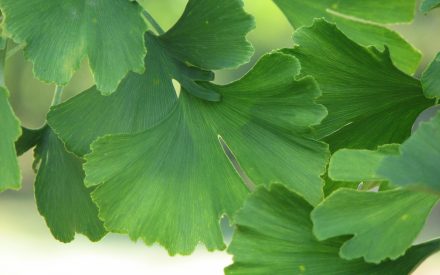 Trees and Shrubs for Diversity and Climate Change
Trees and Shrubs for Diversity and Climate Change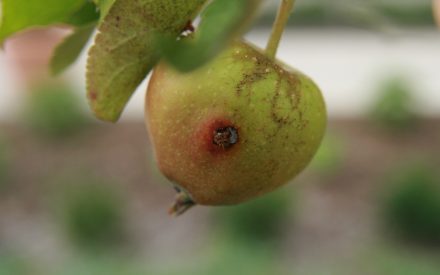 Apple Pest Management for Home Gardeners
Apple Pest Management for Home Gardeners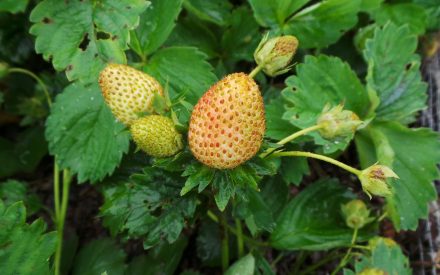 Angular Leaf Spot of Strawberry
Angular Leaf Spot of Strawberry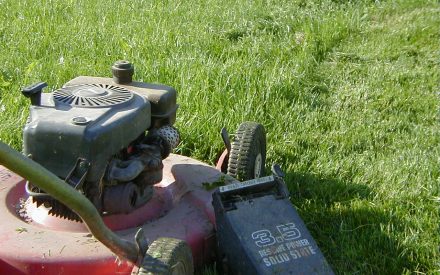 Lawn Maintenance
Lawn Maintenance


